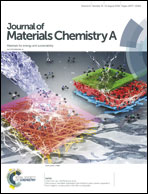Highly durable solid oxide fuel cells: suppressing chemical degradation via rational design of a diffusion-blocking layer†
Abstract
Solid oxide fuel cell (SOFC) technology offers tremendous potential for highly efficient and clean power generation. However, its commercialization has lagged owing to the lack of long-term stability. Among the various sources of performance degradation, the interdiffusion between the cathode and electrolyte has been identified as a predominant factor. Herein, we demonstrate a highly reliable diffusion-blocking layer that completely suppresses detrimental chemical interactions at elevated temperatures. This diffusion-blocking layer is constructed via a bilayer approach, in which the top and bottom layers perform individual functions to precisely control the bulk and interfacial properties. Harnessing two types of specially designed nanoparticles for each part enables the realization of the desired film structure. Consequently, the formation of insulating phases and decomposition of the cathode are effectively prevented, resulting in a remarkable improvement in performance and stability. The scalability and feasibility of mass production are verified via the fabrication of large cells (10 cm × 10 cm) and a multi-cell stack. The stack in which the bilayer technique is implemented exhibits an extremely low degradation rate of 0.23% kh−1, which fulfills the strict lifetime requirement for market penetration. This work highlights a scalable, cost-effective, and reproducible method for the production of highly durable multilayer energy devices, including SOFCs.



 Please wait while we load your content...
Please wait while we load your content...